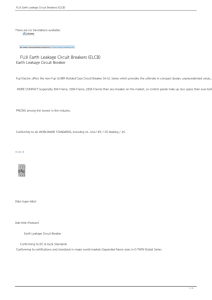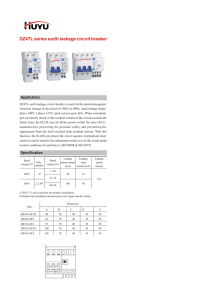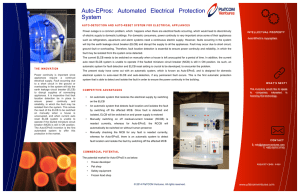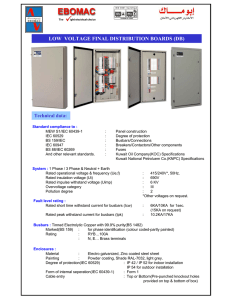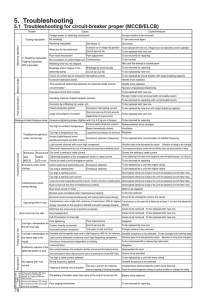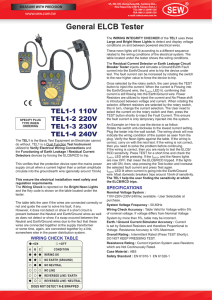WHY ELECTRONIC and NOT ELECTROMECHANICAL ELCB`s ?
advertisement
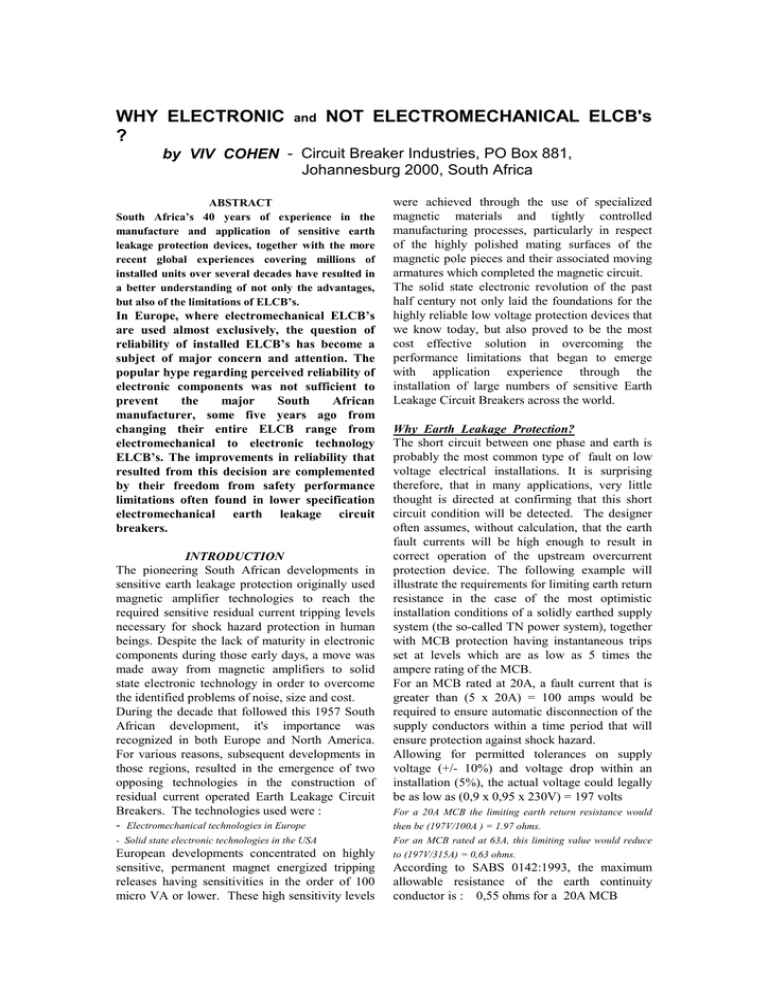
WHY ELECTRONIC ? and NOT ELECTROMECHANICAL ELCB's by VIV COHEN - Circuit Breaker Industries, PO Box 881, Johannesburg 2000, South Africa ABSTRACT South Africa’s 40 years of experience in the manufacture and application of sensitive earth leakage protection devices, together with the more recent global experiences covering millions of installed units over several decades have resulted in a better understanding of not only the advantages, but also of the limitations of ELCB’s. In Europe, where electromechanical ELCB’s are used almost exclusively, the question of reliability of installed ELCB’s has become a subject of major concern and attention. The popular hype regarding perceived reliability of electronic components was not sufficient to prevent the major South African manufacturer, some five years ago from changing their entire ELCB range from electromechanical to electronic technology ELCB’s. The improvements in reliability that resulted from this decision are complemented by their freedom from safety performance limitations often found in lower specification electromechanical earth leakage circuit breakers. INTRODUCTION The pioneering South African developments in sensitive earth leakage protection originally used magnetic amplifier technologies to reach the required sensitive residual current tripping levels necessary for shock hazard protection in human beings. Despite the lack of maturity in electronic components during those early days, a move was made away from magnetic amplifiers to solid state electronic technology in order to overcome the identified problems of noise, size and cost. During the decade that followed this 1957 South African development, it's importance was recognized in both Europe and North America. For various reasons, subsequent developments in those regions, resulted in the emergence of two opposing technologies in the construction of residual current operated Earth Leakage Circuit Breakers. The technologies used were : - Electromechanical technologies in Europe - Solid state electronic technologies in the USA European developments concentrated on highly sensitive, permanent magnet energized tripping releases having sensitivities in the order of 100 micro VA or lower. These high sensitivity levels were achieved through the use of specialized magnetic materials and tightly controlled manufacturing processes, particularly in respect of the highly polished mating surfaces of the magnetic pole pieces and their associated moving armatures which completed the magnetic circuit. The solid state electronic revolution of the past half century not only laid the foundations for the highly reliable low voltage protection devices that we know today, but also proved to be the most cost effective solution in overcoming the performance limitations that began to emerge with application experience through the installation of large numbers of sensitive Earth Leakage Circuit Breakers across the world. Why Earth Leakage Protection? The short circuit between one phase and earth is probably the most common type of fault on low voltage electrical installations. It is surprising therefore, that in many applications, very little thought is directed at confirming that this short circuit condition will be detected. The designer often assumes, without calculation, that the earth fault currents will be high enough to result in correct operation of the upstream overcurrent protection device. The following example will illustrate the requirements for limiting earth return resistance in the case of the most optimistic installation conditions of a solidly earthed supply system (the so-called TN power system), together with MCB protection having instantaneous trips set at levels which are as low as 5 times the ampere rating of the MCB. For an MCB rated at 20A, a fault current that is greater than (5 x 20A) = 100 amps would be required to ensure automatic disconnection of the supply conductors within a time period that will ensure protection against shock hazard. Allowing for permitted tolerances on supply voltage (+/- 10%) and voltage drop within an installation (5%), the actual voltage could legally be as low as (0,9 x 0,95 x 230V) = 197 volts For a 20A MCB the limiting earth return resistance would then be (197V/100A ) = 1.97 ohms. For an MCB rated at 63A, this limiting value would reduce to (197V/315A) = 0,63 ohms. According to SABS 0142:1993, the maximum allowable resistance of the earth continuity conductor is : 0,55 ohms for a 20A MCB 0,24 ohms for a 63A MCB This leaves ( 1.97 - 0,55 ) = 1.42 ohms TOTAL for the supply circuit AND fault resistance in a circuit incorporating a 20A MCB, or ( 0,63 - 0,24 ) = 0,39 ohms for the case of a 63A MCB. Furthermore, most regulations permit a phase to earth loop impedance up to the point of supply of up to 1 ohm. When considering that not all earth faults are bolted faults, it can easily be seen that it can not always be guaranteed that sufficient earth fault current would be available to trip the MCB within a sufficiently short time period to prevent shock hazard. SABS 0142:1993 requires all socket outlets to be protected by 30mA sensitive ELCB's, so removing the tight restrictions on limiting resistance of the earth return continuity path for ELCB protected circuits. However, the above examples confirm the need for the close attention that should be paid to earth continuity paths of circuits in an installation that are not protected by ELCB's, at both design and maintenance stages. ELCB Energy Considerations For core balance earth leakage systems, the residual current is detected through the excitation of a zero sequence transformer, through which all the ACTIVE conductors of the protected circuit are monitored. Due to the very low energy levels involved, the zero sequence transformer needs to be constructed from specialized low loss, high permeability materials. It furthermore needs to be excited to a level that will ensure optimum energy transfer to the load to which it is connected. Optimum energy transfer is obviously a function of the ELCB detector load impedance In power dependent systems (electronic ELCB's), the load impedance of the detector circuit (as seen by the secondary winding of the zero sequence transformer), at first sight, appears to be relatively high. However, when this impedance is reflected to the primary of the zero sequence transformer, it becomes very low as a result of the high turns ratio demanded for such devices. Using good design techniques, it is relatively easy to achieve good impedance matching with this type of construction. Power independent (Electromechanical ELCB's) differ from their electronic counterparts by using very low turns ratio zero sequence transformers which feed into relatively low impedance tripping releases. The resulting effective detector impedance in this case is however, relatively high, when reflected to the primary through the low turns ratio that is typical in such systems. The impedance matching and power transfer characteristics of such systems are difficult to maintain under adverse operating criteria. PERFORMANCE LIMITATIONS of ELCB's Recognition of the fact that performance limitations had been identified with these sensitive protection devices was insufficient to dampen the enthusiasm of researchers and manufacturers alike into developing what has today become a major industry. Residual Current Devices (RCD's) or Earth Leakage Circuit Breakers (ELCB's) as they are known in South Africa, have unquestionably made a significant contribution to the provision of safe electricity. Technological developments over the past four decades have resulted in ELCB's becoming a cornerstone in the ambitious electrification projects of the new South Africa. European and North American priorities in dealing with the identified performance limitations of ELCB's differed and were influenced not only by the basic ELCB technologies used in those regions, but also by vested commercial interests and the nature of the distribution systems into which they were installed. South Africa was fortunate in being able to exploit both types of technology through a highly competitive manufacturing presence. The vast application experience gained in South Africa through the use of ELCB's having different construction technologies in similar locations, over several decades, was invaluable and instrumental in more recent decisions regarding the manufacturing standards of at least one large manufacturer of these devices. Power Dependent Electronic ELCB's ELCB's that use electronic sensing means are dependent on an external energy supply for their operation. The external energy supply for ELCB's is generally restricted to the supply being derived from the power supply mains. For obvious reasons, the integrity of the service neutral conductor needs to be ensured to prevent hazardous situations arising. With power independent ELCB's such as the electromechanical European types, interruption of the neutral conductor does not result in any performance degradation, since these are CURRENT operated devices. The older types of power dependent ELCB's however, do require the integrity of the service neutral conductor to be ensured. More recent developments in electronically operated ELCB's have resulted in a total solution to the "bogey" of broken neutrals, through the provision of a logical alternative energy supply source by way of a functional earth connection. the neutral conductor is detected, ensuring full protection even under abnormal conditions. FUNCTIONAL EARTH Functional Earth Connection It has been argued in some quarters that the statistical probability of accidents resulting from broken neutral conductors is relatively low, since several fault conditions would be required to occur simultaneously for a hazardous situation to arise. In recognition however of even the remote possibility of hazardous situations arising, this potential shortcoming in ELCB's has been entirely overcome by the introduction of a FUNCTIONAL EARTHING connection into modern electronically operated ELCB's. The functional earth provides an alternative path for ensuring the continuity of supply energy to the ELCB even in the event of a total break in the neutral supply conductor. The low energy requirements of modern ELCB's ensure safe and reliable operation of the ELCB even in extreme situations where the earth return path bond resistance is orders of magnitude higher than that normally permitted by mandatory or utility regulations. Under normal operating conditions, the functional earth (FE) circuit is quiescent and does not influence the performance of the ELCB, whether the FE is connected to earth or not. The connected FE circuit becomes operative immediately a total break or high impedance in Power Independent Electro-mechanical ELCB's Power independent ELCB's rely for their operation on a limited energy source derived from a high permeability, high sensitivity toroidal magnetic core, operating an equally highly sensitive tripping release having a tripping sensitivity of the order of 100 micro VA. The operation of the high sensitivity tripping release is particularly sensitive to minute amounts of pollutant. Foreign matter inclusions at the pole faces can prevent the release armature from closing, whereas minute moisture droplets trapped between the highly polished armature and pole faces can result in total non operation of the tripping release. In summary, any interference, be it from electromagnetic or physical sources can interfere with the delicate balance of this micro system, with possible deleterious effects. In this limited energy system, the deleterious effects, at the best, could involve unplanned tripping of the ELCB, and at the worst, could result in reduced tripping sensitivity leading to total non-tripping conditions in extreme circumstances. Residual Currents with d.c. Components Modern appliances, to an ever increasing extent, depend on electronic control systems for their operation, convenience and cost. It is an unfortunate fact that the quality of both design and components used in appliances can vary from very good, to questionable. This has resulted in the real probability of the introduction of uncancelled unidirectional or pulsating d.c. components into the load current by certain appliances under normal operation or fault conditions. d.c. COMPONENTS in RESIDUAL CURRENT Even the slightest presence of uncancelled pulsating d.c. components in the residual fault current can dramatically desensitize electromechanical ELCB's due to changes in the effective incremental permeability of the toroidal zero sequence transformer through which the power supply conductors need to be routed. It is only in special types of electromechanical ELCB's, that this potentially hazardous problem can be solved through the use of more costly components which are still only available from restricted supply sources. The desensitizing effect of pulsating d.c. components in the residual current of electronically operated ELCB's is sufficiently low to allow well designed devices to easily meet the prescribed safety standards. Fault Between Earth and Neutral It is an inherent requirement, for the successful operation of all core balance operated ELCB's, that the service neutral be connected to earth on the supply side of the ELCB, to provide a return path for residual earth leakage currents. On the other hand, it is a further basic requirement of most national and international wiring rules, that the neutral conductor is not earthed at any point downstream of the point of supply. Any intentional or inadvertent connection of the neutral to earth in an installation, will complete what is equivalent to a short circuited turn through the sensing toroid of the ELCB, to the supply side neutral/earth connection. The desensitising effect of such a short circuited turn on ELCB's is inversely proportional to the resistance of the shorted loop and is also very dependent on the reflected impedance of the detection device in the ELCB. Power independent electromechanical type ELCB's are particularly susceptible to desensitization under these conditions. Experience has shown that in practice, there is a high probability of such a normally undetected fault condition arising. Unlike North American and South African standards, it is unfortunate that the IEC product standard for ELCB's has thus far chosen to ignore this serious shortcoming, on the grounds that the ELCB would in any event be caused to trip through the division of load current through the neutral and earth conductors. While this assumption is true up to a point, it must be remembered that the load current will divide according to the inverse ratio of the neutral circuit impedance to the earth circuit impedance. The amount of load current that is needed to result in tripping of the ELCB under desensitized conditions could, in some circumstances exceed many hundreds or even thousands of milliamperes. During periods of low load demand, as in the early morning hours, such a situation could result in the major portion of this load current flowing through extraneous earth paths, without the earth fault being detected by the ELCB. It has been well documented that currents flowing through uncontrolled return paths could, at levels exceeding about 300 milliamps, result in potential incendiary conditions and consequential fire hazards. By virtue of their design and relative freedom from the need for highly specialized magnetic materials for the zero sequence detection toroids, electronically energized ELCB's experience only minimal degrees of desensitisation under these conditions as shown in the figure below. EFFECT OF NEUTRAL -EARTH FAULT 6(16, 7,9, 7< PD 32:(5 ,1'(3(1'(17 32:(5 '(3(1'(17 /223 5(6,67$1&( RKPV RELIABILITY of ELCB's There is little question as to the acceptance of ELCB's and the important role that these devices have played in the protection against both shock hazard and electrical fire hazard. Conservative estimates are that several hundreds of millions of these devices have been installed around the world. It has been prudent therefore, in consideration of the high expectations in regard to the protection afforded by ELCB's, to investigate the levels of long term reliability that can be expected from these devices. In Europe, where electromechanical ELCB's are used almost exclusively, the results of these investigations have led to the question of reliability of installed ELCB's becoming a subject of major concern and attention, with failure rates of between 2,5% and 7,5% being documented. Investigations have shown that most failures can be attributed to the highly sensitive tripping releases that are used in power independent electromechanical ELCB's. Underwriters Laboratories in the United States of America, on the other hand, having labelled over two hundred million devices (which they refer to as GFCI's), report that in response to their enquiries, there is little evidence of reliability problems with GFCI's ... "and no support to expend resources to perform special field tests on a product that appears to be performing satisfactorily". The South African experience tended to confirm the European findings, but a national investigation which covered over seventeen thousand devices, indicated a far lower failure level with electronically operated ELCB's than was the case with electromechanical ELCB's. After careful consideration of both manufacturing reject levels and field returns, the popular hype regarding the perceived reliability of electronic components was not sufficient to prevent the major South African manufacturer, after 30 years, from changing their entire ELCB range from electromechanical to electronic technology, despite an obviously strong initial hesitation in taking this bold step. Earlier problems of damage to electronic components due to a combination of imperfect system earthing and lightning voltage surges were overcome through appropriate design enhancements that were shown to be necessary to suit the extreme environmental and installation requirements peculiar to South Africa. Developing technology has shown that in all parts of the world, failure rates have decreased as technology has progressed. At the time of writing, field failures of ELCB's in South Africa have been reduced to levels that are now low enough to permit controlled examination of the few remaining identified failures, in determining the real causes of failure. Ongoing field investigations are confirming the inherent reliability of modern electronically operated ELCB's. These investigations are also highlighting the importance of the attention that needs to be given, not only to good installation practice, but also for the need for adequate overvoltage control on the low voltage side of network supply transformers. Whilst it was possible, at minimal cost, to enhance the power frequency withstand voltage of ELCB's to cater for the abnormal faulted condition of continuous phase-to-phase voltage on 230 volt single phase supply systems, such low cost solutions are unlikely in dealing with uncontrolled surge voltages that have been shown to reach tens of kilovolts on the low voltage supply network. CONCLUSIONS The improvements in ELCB reliability that resulted from the decision by the major South African manufacturer to abandon their commitment to electromechanical ELCB's are complemented by the relative freedom of performance limitations of modern electronically operated ELCB's which are often found in lower specification electromechanical earth leakage circuit breakers. The problem of damage due to uncontrolled overvoltage surges is certainly not unique to electronically operated ELCB's. The insulation clearances specified and used in most low voltage installation equipment and protection components (including MCB's and electromechanical ELCB's) are such that surge voltages that exceed 4KV to 6KV could also be potentially damaging to these devices. In consideration of the large number of existing installations, together with those scheduled to be installed over the next several years, simple logic suggests (as is the situation in most other countries), that the provision of overvoltage control on the low voltage supply network would be a far more economically desirable solution than attempts at even further enhancement of ELCB overvoltage withstand capabilities. REFERENCES i) Electrical shock and fire hazard protection - conquering the limitations - by V Cohen - "Elektron" September 1993. ii) SABS 767 - 1982 - Earth Leakage Protection Units iii) IEC 1008-1 - Residual current operated circuit breakers iv) UL 943 - Ground Fault Circuit Interrupters v) SABS 0142-1993 Code of Practice- Wiring of Premises vi) South Africa - A pathfinder in Earth Leakage protection by V Cohen published in "Elektron" January 1992. vii) Electrical shock hazard protection - by V Cohen published in "Vector" January 1993. viii) Effect of multiple neutral earthing systems on consumer's installation - by V Cohen - "Vector" Aug. 1983. ix) Why electronic & not electromechanical ELCB’s - V Cohen Cape Technikon-April 1996 & “Elektron”magazine May 1996
